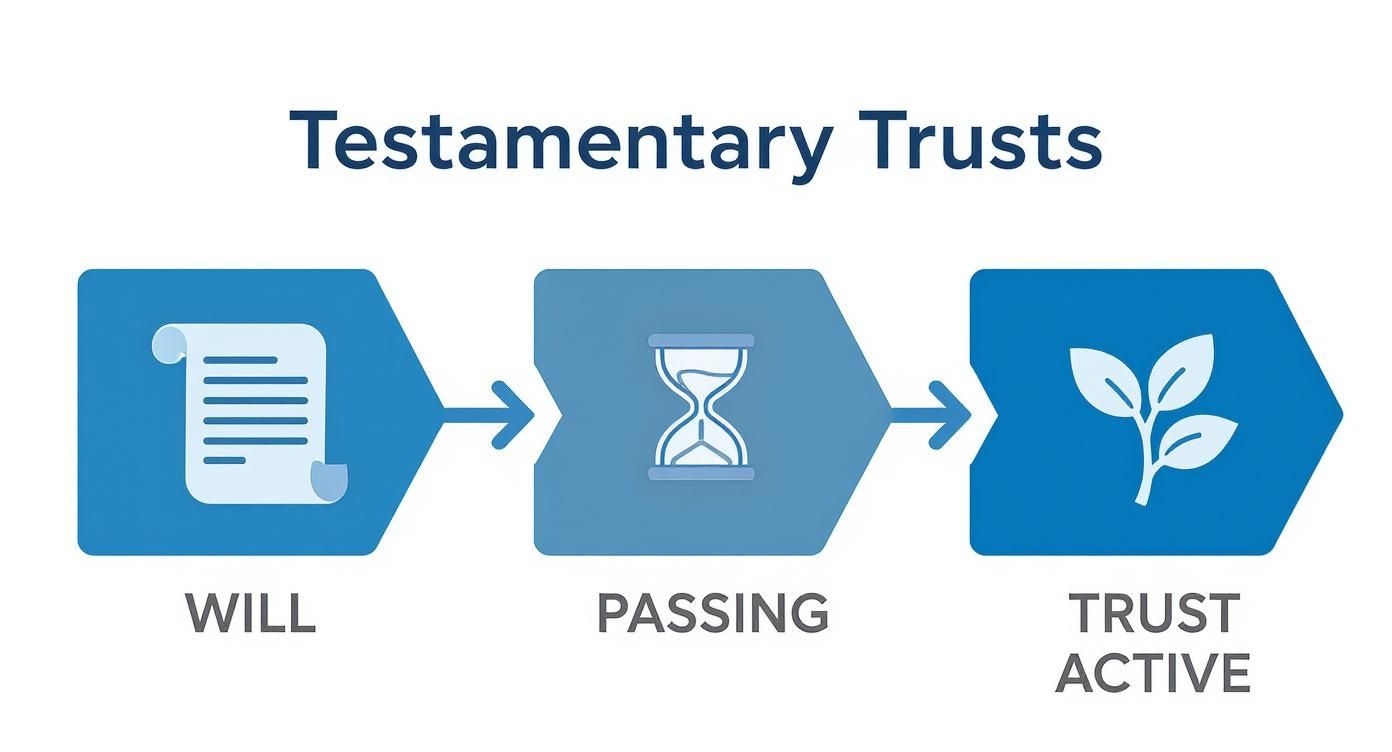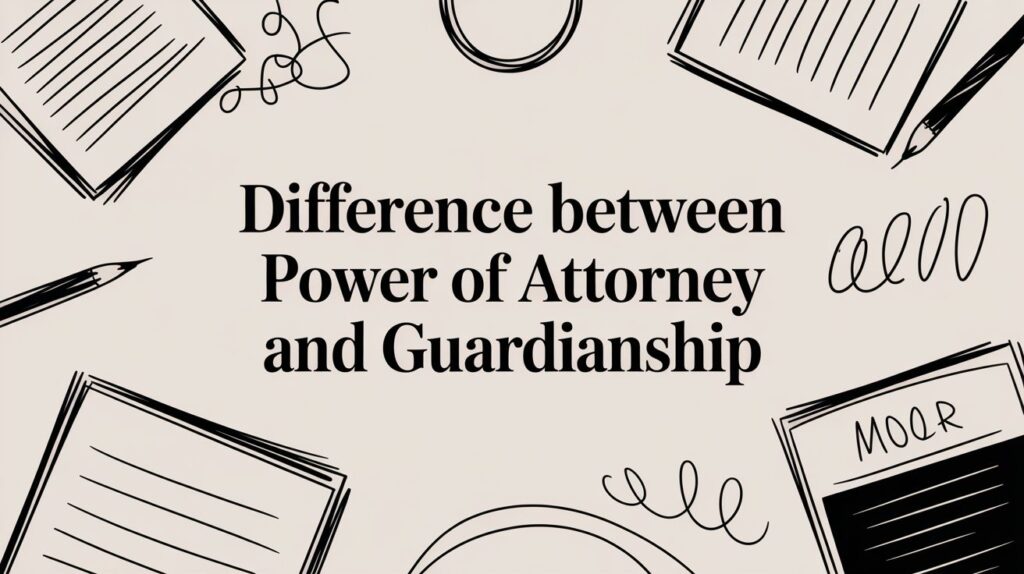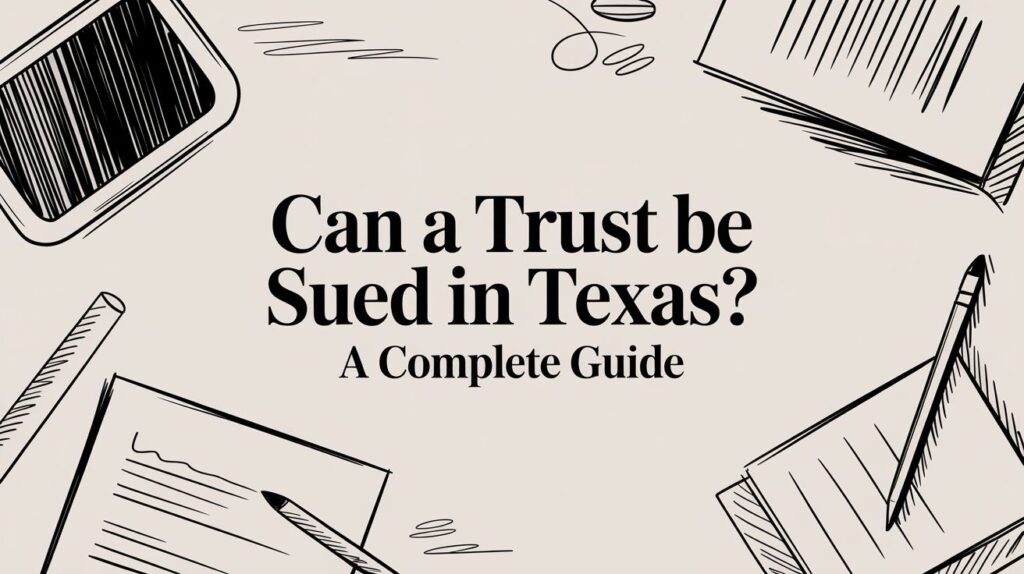Planning for your family's future after you're gone can feel overwhelming, but with the right legal guidance, it doesn’t have to be. A testamentary trust is one of the most powerful tools available in Texas estate planning. Created within your Last Will and Testament, it is a unique legal structure that only comes into existence after your passing, allowing you to provide for and protect your loved ones according to your precise wishes. Understanding how it works is the first step toward building a secure legacy.
A Foundational Tool in Texas Estate Planning
When you're mapping out your family's financial future, clarity and control are essential. A testamentary trust is a set of detailed instructions included in your will, designed to manage and distribute your assets to your beneficiaries. This "trust within a will" is not activated until your will goes through the Texas probate process—the legal proceeding that validates it. In Texas, the creation and administration of these trusts are governed by the Texas Estates Code and the Texas Trust Code, which provide a solid legal framework for your final wishes.
This type of trust gives you significant control over your legacy long after you are gone. You can specify not just who receives your assets, but also how and when they receive them. For many Texas families, this level of control is crucial for protecting beneficiaries and preserving wealth for future generations.
Key Purposes of a Testamentary Trust
One of the primary reasons individuals establish a testamentary trust is to provide for beneficiaries who may not be equipped to manage a large inheritance immediately. This is particularly beneficial for:
- Protecting Minor Children: You can ensure their inheritance is managed by a responsible adult (the trustee) until they reach an age you deem appropriate, such as 25 or 30.
- Supporting a Beneficiary with Special Needs: This allows you to provide financial support without inadvertently disqualifying them from essential government benefits like Medicaid or SSI.
- Safeguarding Assets for an Adult: It provides a way to manage an inheritance for a loved one who may struggle with financial decisions or needs protection from creditors.
By setting these clear rules, you can have peace of mind knowing your assets will be used exactly as you intended. A well-drafted plan, created with the help of a Texas estate planning attorney, ensures your wishes are legally binding and your family's future is secure.
How a Testamentary Trust Is Formed After Probate
A testamentary trust is like a blueprint for a house tucked inside your will. The trust does not spring into existence the moment you sign your will. Instead, your will contains the detailed instructions, waiting for the appropriate time for the trust to be "built." This construction can only begin after the legal foundation is laid through the Texas probate process.
The process starts after you pass away. The person you've named as your executor submits your will to the probate court. The court's initial responsibility is to validate the will, ensuring it meets all legal requirements under the Texas Estates Code. Only after the will is officially "admitted to probate" can the instructions within it be executed. It is at this moment that the testamentary trust formally comes to life.
The graphic below illustrates this three-step journey, showing how a plan on paper becomes a fully active trust.

As you can see, the trust remains dormant within the will until the probate court authorizes its creation. This is a critical distinction from other estate planning tools, like living trusts, which are active from the moment they are signed and funded.
The Transition From Executor to Trustee
Once the court validates the will, two critical roles come into focus: the executor and the trustee. It is common for these roles to be held by different individuals.
- The Executor: This person is responsible for managing your entire estate during the probate process. Their duties include gathering your assets, paying any outstanding debts, and filing final tax returns.
- The Trustee: This individual or institution is appointed to manage the trust itself. After the executor has settled the estate's general affairs, they will transfer the designated assets into the newly created trust.
From that point on, the trustee takes charge. They are legally bound by fiduciary duties in Texas to manage the trust assets according to the precise rules you established in your will. This handoff is a critical step that ensures your specific wishes are followed meticulously.
Think of it this way: the executor’s job is temporary—they settle the estate and fund the trust. The trustee’s role, on the other hand, is built for the long haul, focused on managing that trust for your loved ones for years, or even decades.
Understanding this sequence is vital, whether you are creating the will or tasked with carrying out its instructions. The Texas legal system provides a structured, supervised path to bring your final wishes to life, ensuring every step is handled correctly and with full legal authority. This process is designed to protect your legacy and, most importantly, the beneficiaries you intend to support.
Testamentary Trust vs. Living Trust
When exploring estate planning options, it is easy to become confused by the terminology. The word "trust" is often used broadly, but in Texas, two of the most common types—testamentary trusts and living trusts—operate in fundamentally different ways.
Think of them as two different tools for managing assets: one is built before your journey ends, while the other is assembled after you've reached your final destination.
A testamentary trust is a blueprint contained within your will. It doesn’t exist until after you pass away and your will goes through the court process known as probate. In contrast, a living trust (or inter vivos trust) is a legal entity you create and fund with assets while you are still alive. This fundamental difference in timing dictates their unique features and functions.
The Critical Role of Probate
The most significant distinction between these two trusts is their interaction with the Texas probate process.
Because a testamentary trust is created by a will, it cannot avoid probate. Your will must be validated by a Texas court before the trust can officially be established and funded with your assets. This means the process is a matter of public record, supervised by a judge, and can take time to complete.
A living trust, however, is specifically designed to avoid probate. Since you transfer property into the trust during your lifetime, those assets are not part of your probate estate when you die. This allows for a more private and often faster transfer of wealth to your beneficiaries.
The bottom line is simple: if avoiding probate is a primary goal for your family, a living trust is the more effective tool. A testamentary trust is fundamentally tied to the probate court's oversight.
Funding and Activation Differences
Another key distinction is when these trusts are funded and become operational.
- Testamentary Trust: This trust is merely an instruction on paper until after your death. Your estate's executor is responsible for gathering your assets and, once the court approves, transferring them into the newly formed trust.
- Living Trust: This trust is funded by you during your lifetime. You will actively retitle assets like your home, bank accounts, and investments into the name of the trust, making it a functional entity from the start.
Because a living trust is operational while you're alive, it offers a powerful benefit a testamentary trust cannot: protection against incapacity. If you become unable to manage your own affairs, your chosen successor trustee can step in without needing a court to appoint a guardian. If that proactive approach sounds appealing, learning how to create a living trust in Texas is a great next step.
So, how do you choose? The decision depends on your family's specific needs and goals. Let's compare the key features side-by-side.
Testamentary Trust vs Living Trust Key Features
This table provides a clear, at-a-glance comparison of the primary characteristics of testamentary trusts and living trusts, helping you understand how they stack up.
| Feature | Testamentary Trust | Living Trust (Revocable) |
|---|---|---|
| When It's Created | At death, through the terms of a will. | During your lifetime. |
| Avoids Probate? | No. It is subject to the probate process. | Yes. Assets in the trust bypass probate. |
| Privacy | Public record, as part of the will filed in probate court. | Private document, not filed with the court. |
| When It's Funded | After death, by the executor of the estate. | During your lifetime, by you (the grantor). |
| Incapacity Planning | Offers no protection if you become incapacitated. | Allows a successor trustee to manage assets if you become incapacitated. |
| Upfront Cost/Effort | Generally lower upfront cost and less administrative work. | Higher upfront cost and requires retitling assets. |
| Effective Date | Becomes effective only after your death and the will is probated. | Becomes effective as soon as it's created and funded. |
| Flexibility | Can be changed by amending your will at any time before death. | Can be changed or revoked by you at any time during your life (if it's a revocable trust). |
Ultimately, the choice between a testamentary and a living trust depends on your priorities. While a testamentary trust may seem simpler and less expensive to establish, the privacy, efficiency, and incapacity planning offered by a living trust are invaluable features for many Texas families.
The Strategic Upside of a Testamentary Trust
Given that it must go through probate, why would someone choose a testamentary trust? The answer often lies in long-term asset protection and the desire for customized legacy planning. While probate is a necessary step, the peace of mind and security a testamentary trust provides for beneficiaries with unique needs can be well worth it.

One of the most powerful functions of a testamentary trust is its ability to build a financial fortress around an inheritance. Assets are not handed directly to a beneficiary; instead, they are legally owned and managed by the trust. This seemingly small distinction creates a significant protective barrier.
Putting a Shield Around Your Beneficiaries' Assets
This legal separation between a beneficiary and their inheritance is a game-changer for asset protection. A properly structured trust can defend assets against a variety of life's challenges:
- Creditors and Lawsuits: If a beneficiary faces financial trouble or a lawsuit, assets held within the trust are generally shielded and cannot be seized.
- Divorce Proceedings: In the event of a beneficiary's divorce, assets in the trust are typically considered separate property, not marital property, protecting your legacy from being divided in a settlement.
- Costly Financial Mistakes: For a loved one who may struggle with managing a large sum of money, the trust ensures the inheritance is managed wisely by a trustee you have selected.
This layer of protection ensures your legacy supports your loved ones as intended, rather than being diminished by lawsuits, divorce, or poor financial decisions.
A Lifeline for Vulnerable Loved Ones
A testamentary trust is an essential tool for providing for beneficiaries who require specialized care or long-term financial support. It allows you to control how and when they receive assistance without unintentionally causing other problems.
For example, consider a child with special needs who relies on government benefits like Medicaid or SSI. A direct inheritance could increase their assets above strict government limits, disqualifying them from receiving essential aid. By directing the inheritance into a Special Needs Trust (a specific type of testamentary trust), you can provide for their comfort and quality of life without disrupting their eligibility for these vital programs.
This structure is also ideal for minor children. You can use the trust to appoint a trustee to manage their inheritance until they reach an age of maturity you specify, whether that's 25, 30, or even later.
The real beauty of testamentary trusts is their adaptability. Instead of rigid, fixed rules, they allow the trustee to make distributions based on what a beneficiary actually needs after you're gone. This flexibility is a godsend, shielding inheritances from lawsuits or divorces while keeping loved ones eligible for benefits. It's a cornerstone of truly comprehensive estate planning. For a deeper dive into these advantages, you can explore detailed guides on trust benefits.
Ultimately, a testamentary trust provides lasting control. You get to establish the rules for how your assets are managed and used, ensuring your legacy aligns with your values for generations to come. A Texas estate planning attorney can help you design a trust that is perfectly suited to your family's unique circumstances.
Navigating Trustee Responsibilities in Texas
Accepting the role of a trustee for a testamentary trust is a significant legal responsibility, not just an honorary title. When you become a trustee, you become a fiduciary. Under Texas law, this means you are held to the highest standard of loyalty and good faith. This is a serious legal and ethical commitment that demands diligence, integrity, and a clear understanding of your duties under the Texas Trust Code.
Your primary obligation is to manage the trust's assets for the sole benefit of the beneficiaries, following the exact instructions laid out in the will. Texas law holds trustees accountable, and mismanagement of assets or failure to adhere to the trust's terms can result in personal liability and legal disputes. While the role is demanding, with proper guidance, it can be managed with confidence and compassion.
Trustee Responsibilities Under Texas Law
The Texas Trust Code outlines several key fiduciary duties in Texas that every trustee must uphold. These duties form the foundation of trust administration and are designed to protect beneficiaries and honor the creator's intent.
Three of the most critical duties are:
- Duty of Loyalty: You must act solely in the best interests of the beneficiaries. This means avoiding self-dealing and any conflicts of interest between your personal finances and the trust's.
- Duty of Prudence: You must manage the trust's assets as a prudent person would manage their own. This includes making sound investment decisions, protecting trust property, and avoiding excessively risky ventures.
- Duty of Impartiality: If there is more than one beneficiary, you must treat them all fairly and equitably, unless the trust document specifically instructs otherwise.
These are just a few of your legal obligations. For a more comprehensive overview, you can learn about the full scope of trustee duties and responsibilities in our guide.
Step-by-Step Guidance for a Texas Trustee
Beyond these core principles, the day-to-day work of a trustee involves many practical tasks. Effective trust administration requires organization, clear communication, and meticulous record-keeping.
Here is a step-by-step look at what your responsibilities will generally include:
- Take Control of Assets: Once the trust is funded, your first step is to identify all trust property and assume legal control over it.
- Manage and Invest: Develop an investment strategy that aligns with the trust's goals, time horizon, and the needs of the beneficiaries.
- Make Distributions: Distribute funds or property to the beneficiaries according to the schedule and terms established in the will.
- Keep Records and File Taxes: Maintain detailed records of all transactions and file the trust's annual income tax returns.
- Communicate with Beneficiaries: Keep beneficiaries informed about the trust's status and performance to build trust and fulfill your duties.
Managing a trust can feel complex, but you do not have to do it alone. A Texas trust administration lawyer can provide clarity and ensure you are meeting all your legal obligations correctly.
Common Scenarios for a Testamentary Trust
Seeing a testamentary trust in action is the best way to understand its practical value. These are not abstract legal documents; they are real-world tools designed to provide families with security and peace of mind during challenging times. Let's walk through a few real-world scenarios where a Texas testamentary trust is the ideal solution.

Scenario 1: Providing for Minor Children
Maria and David are a young couple with two small children. Their primary concern is ensuring their children would be cared for if something unexpected happened to them. Leaving assets directly to their children in a simple will is not a viable option, as minors cannot legally own property in Texas.
Solution: By including a testamentary trust in their wills, they can appoint a trusted sibling as trustee to manage the assets until both children are old enough to handle the responsibility, for instance, at age 25. The trustee can use the funds for the children's health, education, and general welfare, all according to the specific instructions Maria and David have provided. This creates a secure financial future for their children, overseen by someone they trust.
Scenario 2: Protecting Vulnerable Beneficiaries
Sarah has an adult brother, Tom, who has a disability and relies on government benefits like Medicaid. If Sarah were to leave him a direct inheritance, his assets would exceed the strict eligibility limits, causing him to lose his critical support.
Solution: Sarah’s Texas estate planning attorney helps her establish a testamentary Special Needs Trust.
This type of trust is a game-changer. It allows Tom's inheritance to be used for his benefit—covering things like therapy, special equipment, or even a vacation—without ever counting as his personal asset. The trust money supplements his government aid instead of replacing it, ensuring his quality of life is boosted, not jeopardized.
Scenario 3: Guiding an Inheritance for an Adult Child
A father wants to leave a significant inheritance to his adult son but is concerned about his son's history of poor financial decisions. A lump-sum inheritance could be quickly spent or lost to creditors.
Solution: The father includes a testamentary trust with a "spendthrift" provision in his will. He appoints a professional trustee to manage the inheritance. The trustee makes regular distributions to the son for living expenses while protecting the principal from creditors or impulsive spending. This ensures the inheritance provides a long-term safety net, just as the father intended.
Let's Unpack Some Common Questions About Testamentary Trusts
Estate planning can feel like navigating a maze, and it's completely normal to have questions pop up along the way. To help clear things up, we've put together answers to some of the most frequent questions we hear about using a testamentary trust here in Texas.
Can I Change a Testamentary Trust After My Will Is Signed?
Yes, absolutely. Because a testamentary trust is part of your will, you can modify its terms at any time by creating a new will or amending your existing one with a "codicil."
This flexibility is a significant advantage. It allows your estate plan to evolve with your life circumstances, such as the birth of a child, a change in finances, or a shift in family dynamics. We recommend reviewing your will with a Texas estate planning attorney every few years to ensure it continues to reflect your wishes accurately. Learning how to modify a trust in Texas through your will is a straightforward process with professional guidance.
Do Assets in a Testamentary Trust Avoid Probate in Texas?
No, they do not. This is a critical distinction and one of the most significant differences between a testamentary trust and a living trust.
Any assets designated for the trust must first pass through the Texas probate process as part of your estate. The will must be validated by the court before those assets can be officially transferred from the estate into the trust. A living trust, in contrast, is designed to hold your assets during your lifetime and typically bypasses the probate court entirely.
Who Should I Choose as a Trustee for My Trust?
This is one of the most important decisions in your estate plan. You can appoint a trusted family member, a responsible friend, or a professional fiduciary, such as a bank or trust company.
The ideal trustee is someone who is:
- Responsible and highly organized
- Financially savvy and capable of making prudent decisions
- Impartial and able to act fairly toward all beneficiaries
Consider the complexity of the trust and the needs of your beneficiaries. For complicated family dynamics or complex assets, appointing a professional trustee can prevent conflicts and ensure expert management. It is also wise to name at least one successor trustee in case your first choice is unable or unwilling to serve.
If you’re managing a trust or planning your estate, contact The Law Office of Bryan Fagan, PLLC for a free consultation. Our attorneys provide trusted, Texas-based guidance for every step of the process.







